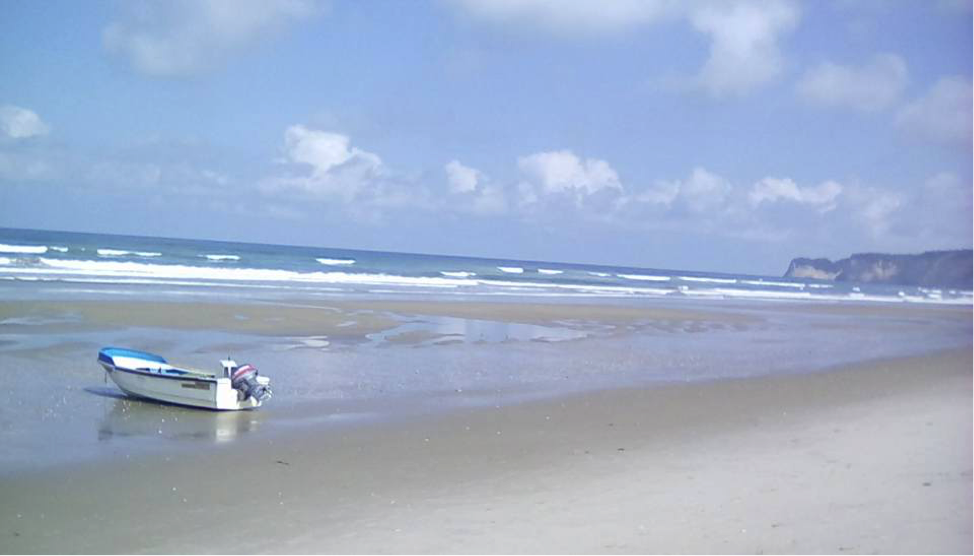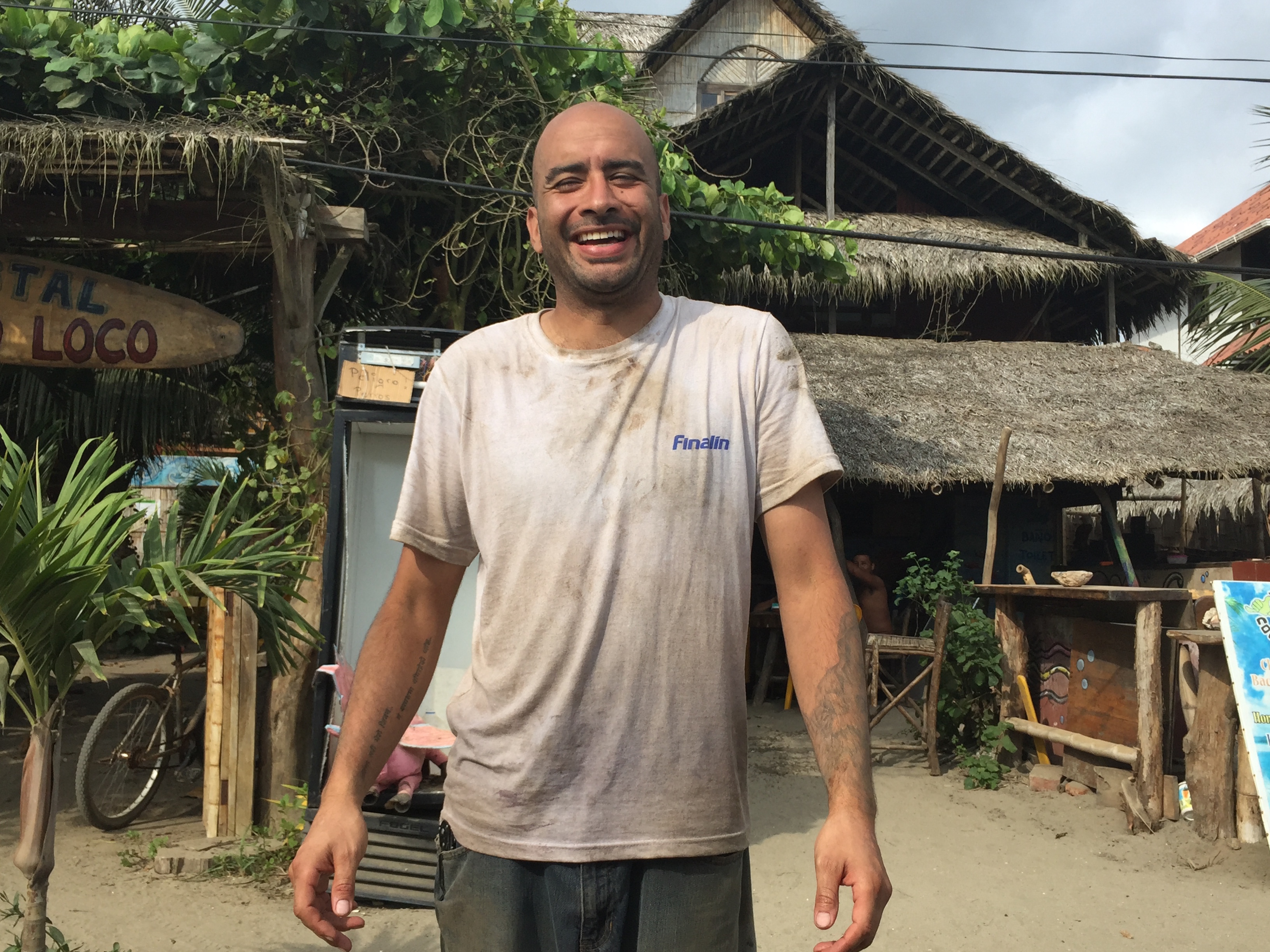A surf town looks to tourists for revival
This is the first in a two part series on tourism-based communities recovering from disaster, and the role of tourists in that recovery. The second segment, focusing on Nepal, will be published in September 2016.

It started gently, just past sunset on a Saturday evening in Canoa, a touristy surf town in Ecuador. Peter Stromberg and his wife Maija were sitting on their couch for dinner, mere days before they planned to open the Canoa Suites hotel. Within a minute that hotel, like much of Canoa, would crumble.
Peter was sprinkling cheese on his bowl of chicken tortilla soup when the tremors started. Within seconds, the full violence of the quake hit, rattling the walls, wrenching the floors. In a jolt, the lights extinguished.
“Get out of the house!” Peter shouted at Maija.
They rushed awkwardly for the door. Around them, the house lurched up and down, back and forth. Maija was flung onto the patio bricks; Peter was thrown into the sand. As he glanced back, Peter saw Maija crawling toward him, saw that one of the walls of their house had moved to where their front door used to be. Chaos erupted on land, the town literally falling to pieces as Peter and Maija were thrown around on the beach, but the ocean beside them was eerily calm.
The 7.8 magnitude earthquake that rocked Ecuador on April 16, 2016 released the energy equivalent of 9.8 million of the atomic bombs dropped on Hiroshima. A security camera in Canoa clocked the quake at 53 seconds. But for a town of two thousand that lost hundreds of lives, 70-85% of its buildings and the influx of tourists that give residents their livelihood, those 53 seconds were only the beginning.
The night of the quake was a critical moment for Canoa, but in a lot of respects it is this moment, months later, that will define the future of the town. The last four months of relief efforts have been largely successful, but Canoa is far from the tourist town it used to be. Its infrastructure is solid but donations are dwindling, and the rebuilding process has barely begun. A traveler who visits Canoa these days can have a stunning impact. For those of us who wonder when we can—indeed, should—visit communities recovering from disaster, Canoa’s defining moment may give us an answer.
* * *
Canoa can be found sandwiched between fishing villages along Ecuador’s coastal province of Manabí. It’s hard to get to: the night buses that run there from Quito bumble down mountains for 6 hours. But after a few days of its turquoise-green ocean and miles of sand, Canoa can be even harder to leave. That was definitely the case for Peter Stromberg when he and his wife first visited for their honeymoon in 2008.

“I decided on day two,” Peter says. “I was walking out of the Coco Loco hostel, and it was sunny, and there were palm trees, and I was going surfing right out the front door… I was like, ‘I’m moving here.’”
Peter and Maija left their lives in Fort Collins, Colorado and set roots in Canoa, where they sold comfort foods like pizza and French toast to tourists. They weren’t the only ones: Canoa’s population includes a mix of locals and expatriates that mostly cater to tourists. (Government reports put tourism as the highest source of income in Canoa, followed by fishing.) Peter and Maija settled 30 steps from the water, where they could surf and paraglide. They were planning to run the Canoa Suites hotel in the same building they made home.
Today, the Canoa Suites are ground zero for Canoa’s revival effort, filled with military personnel and construction workers. The “Maestro” of the effort, Benito “Augusto” Falcones, was one of the first to arrive on the scene.
Augusto is an Ecuadorian construction worker and fisherman who was born just down the road from Canoa. Like Peter, he was sitting down to dinner when the quake hit. He grabbed his wife and two kids and huddled under a doorframe, like he was taught to do in school.
“It was like an atomic bomb exploded,” Augusto says. “Dust everywhere, people screaming.”
The entire structure of Augusto’s home collapsed—except for the doorframe. Around 4 in the morning, Augusto’s cell phone started working again. He called his family, and then he called his friend Peter, who was driving around collecting the injured in his pickup truck. “I’m on my way,” Augusto told him.

Canoa didn’t receive any outside assistance for 72 hours—Peter’s truck served as the town’s ambulance. Slowly, a team of nurses and first responders took shape. Peter and Augusto recruited a cleanup and a demolition crew of two hundred and fifty men and women. Expatriates turned to their home countries for help, and tens of thousands of dollars went to crisis control, right back into the hands of the locals working on the ground. Today, the majority of Canoa is clear of rubble.
“We were incredibly organized—everyone well informed and well uniformed!” Augusto says. “Thanks to that, we’re ready to rebuild.”
But Canoa can’t rebuild. They have teams of construction workers, all reporting back to Augusto; they have building permits for earthquake-ready housing trickling in. But they’re missing something crucial: money.
Canoa’s residents have founded an organization called Canoa Reviva to raise the money for reconstruction. Donations are crucial to get the town back on its feet. But they won’t really breathe life back into Canoa—only tourists can do that.
* * *
“I’m not a hero,” Augusto says. “I do this because I have to. I have to save Canoa, because if Canoa isn’t saved, I have no livelihood. What foreigner would visit a town of nothing?”
Canoa lost a lot of structures—the number of hotels and hostels dropped from around 120 to fewer than 15, according to Peter—but it is far from a town of nothing. A lot of restaurants have popped up again on the beach. The high-end hotel made it through; so did the “fancy” grocery store down the road in Bahía. There are backpacker hostels and hotels that cater to the average-spending tourist. And Canoa’s capacity is growing. Many hotels are gearing up to reopen their doors for the high season this winter—Peter and Maija’s Canoa Suites included.
It may seem intimidating to visit a community in recovery. After all, visiting too soon—in the immediate aftermath of disaster, for instance—can be difficult and chaotic, not to mention a strain on resources needed locally for relief. But wait too long, and the community’s economy could atrophy. In the case of Ecuador, the sweet spot for tourism’s return cannot be circled on a calendar. While Canoa opens its doors, the town of nearby Bahía is still cleaning through the wreckage. If we were to use Canoa as a yardstick for readiness for tourism, it wouldn’t be in months since disaster struck; it would be by its thirst to host anew, and if Peter and Augusto are any indication, Canoa is ready.
“We just reopened the discoteca!” Augusto says.
Thankfully, tourists are starting to come back. They are walking the beach where Peter and Maija ran to as their town fell apart, and if all goes well, tourists will continue to walk that beach as the town is rebuilt. “[Tourism] gives the locals hope,” Peter says. “There’s rubble on the ground but we still have a beautiful beach that can stand the test of time, and that’s what’s pulling us through.”
Canoa Reviva is funded through the NGO Ecuador Earthquake Relief Fund. You can support the reconstruction efforts in Canoa by donating to the Ecuador Earthquake Relief Fund or through the CanoaReviva GoFundMe page.
Read Ethical Traveler's Reprint Policy.
